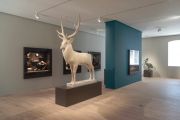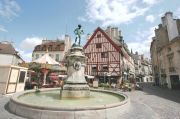 |

|
 Palace of the Duke of Burgundy © Alain Doire BFC Tourisme Palace of the Duke of Burgundy © Alain Doire BFC Tourisme

|
Only 1.5 hours away from Paris by TGV, Dijon is a perfect destination for tourists searching for epicurean and cultural delights.
[ Practical ]
Getting there
- By road
315 km from Paris on autoroute A6.
- By train
TGV from Paris Gare de Lyon to Dijon. The journey takes 1 h 40.
Lodging
- Hotels
Grand Hôtel La Cloche
Mercure Dijon Centre
Maison Philippe le Bon
Hôtel des Ducs
- Bed and breakfast
Le Petit Tertre
Restaurants
La Maison des Cariatides
Le Pré aux Clercs
Restaurant William Frachot
L’Aspérule
What to do
- Musée des Beaux Arts
1 rue Rameau, 21000 Dijon
Open every day except Tuesday from 10am to 6.30pm
Admission free
Tel: 0380745209
beaux-arts.dijon.fr
- Musé Magnin
4 rue des Bons Enfants, 21000 Dijon
Open Tuesday to Sunday from 10am to 12.30pm and from 1.30pm to 6pm
Admission : €3,50 / €2,50
Tel: 0380664375
musee-magnin.fr
- Moutarderie Fallot
16 rue de la Chouette, 21000 Dijon
Open every day from 10am to 7pm
Tel: 0954011262
www.fallot.com
Good to know
Available for 24 h, 48 h or 72 h, the Dijon City Pass card gives access to a selection of museums, monuments and activities as well as to the town public transports.
Price : €25 to €49.
Information
- Dijon tourist office
Tel : 0892700558
www.destinationdijon.com
Close to the railway station, easy to explore on foot, the historic centre of Dijon boasts a large number of monuments, ancient houses, museums and excellent restaurants. It owes a large part of its rich heritage to the Dukes of Burgundy who in the 14th and 15th centuries were as powerful if not more than the Kings of France and made Dijon their capital as well as one of the most flourishing cities in Europe.
Built in the 14th and 15th century, their palace was extensively redesigned in the 17th and 18th centuries in the classical style when was built the semi-circular square where it stands.

 Fine Arts Museum © Alain Doire BFC Tourisme Fine Arts Museum © Alain Doire BFC Tourisme
|
 Rich museum Rich museum
Surrounded by arcades occupied by shops, it is a work by Jules Hardouin-Mansart, the architect of Versailles.
The palace now houses the city hall and the recently restored Fine Arts Museum. One of the richest in France, it is famous for the tombs of Dukes Philip the Bold, John the Fearless and his wife, Margaret of Bavaria whose the strikingly realistic recumbent figures lie on slabs of black marble surrounded with sculptures featuring a procession of mourners. However you can easily spend few hours there as its very large collections comprise around 130 000 artefacts and works of art ranging from Antiquity to the present day, such as Egyptian funeral masks, medieval Italian, Swiss, German and Flemish paintings, canvases from all over Europe from the Renaissance and the following centuries as well as impressionist and modern works. There are also two rooms highlighting the work of two well-known sculptors from Dijon.
 Panoramic view Panoramic view
François Rude, author of the high relief named “The Departure of the Volunteers of 1792 » adorning Paris’ Arch of Triumph, a plaster copy of which is on display.
François Pompon, pupil of Rodin, worldwide known for his sculptures of animals, the most famous one depicting a white bear. If you like it, a large copy of the latter is visible in Square Darcy, near the railway station.
The Palace is dominated by the 46 m high Philipp the Good Tower which you can climb by a staircase of 316 steps. The reward is worth the effort because once at the top you will have a superb panoramic view of Dijon. Once nicknamed the “city of a hundred steeples”, it no longer has as many religious buildings although the choice is still large and three of them are worth a detour. The Well of Moses, masterpiece of medieval sculpture, a Calvary adorned with six strikingly life-like statues of prophets
that you will find in the cloister of an ancient Charterhouse turned into a hospital.

 Old Dijon © Le Boat BFC Tourisme Old Dijon © Le Boat BFC Tourisme
|
 Make your wishes come true Make your wishes come true
The charming chapel of the Elected representatives, accessible via the tourist office, built in the 18th century and boasting a marble altar designed by a Florentine artist. The church of Notre-Dame, a Gothic building whose facade is decorated with three rows of gargoyles alternating with graceful arcades and surmounted by the Jacquemart clock comprising four automata striking a bell to mark quarter hours, half hours and hours. It is also known for the tiny owl carved on the outside wall of one of its chapels because legend says that rubbing it with the left hand makes wishes come true.
The surroundings are a maze of alleys and streets lined with an impressive number of medieval half-timbered houses and wealthy private mansions with flamboyant Gothic, Renaissance or classic facades. Rue des Forges, rue de la Chouette and rue Chaudronnerie are good spots to see many of them.
 Mustard and gingerbread Mustard and gingerbread
The neighbourhood is also home to the Magnin Museum presenting works by little known minor masters from French and European schools from the 16th to the 19th centuries alongside 18th century and Empire pieces of furniture.
Besides, the historic heart of the city is also a heaven for epicureans with a multitude of bars, restaurants and shops as well as a covered market with a metallic structure where you can taste or buy blackcurrant liqueur, Burgundy wines and local culinary specialities. These include parsley seasoned ham, snails, Burgundy truffles, epoisses, a soft cheese, gingerbread supposedly introduced into Burgundy by Marguerite de Flandres in the 14th century whose history and ingredients will be taught to you by Maison Mulot and Petitjean that produces it since 1796. Without forgetting, of course, Dijon mustard, made from seeds and vinegar, not to be mixed up with Burgundy mustard blended with white wine.
 Dijon’s wines Dijon’s wines
Moutarderie Fallot is the best place to appreciate the subtle difference between the two and learn all the secrets of this condiment. You can even attend a course teaching you how to make your own mustard starting from the seeds of this plant. As for wines, Dijon has undertaken to revive the vineyard that once existed on its territory and during the last four years 100 ha have been replanted and given on loan to renowned winegrowers of the Côte de Nuits. Due to get soon the Côtes de Dijon appellation, the wines from these vineyards are still difficult to find but you will probably be able to taste them during a very pleasant event organized every Thursday by the Tourist Office. Named Jeudivins, it offers a commented tasting of a selection of Burgundy wines in unusual venues such as the top of the Philipp the Good Tower, a mansion, a theatre or a church.
May 03, 2020
Thierry Joly 

|



